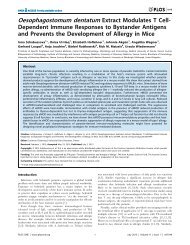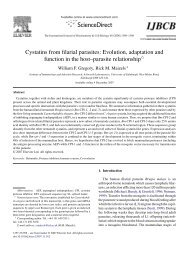Experimental Parasitology - Rick Maizels' Group - University of ...
Experimental Parasitology - Rick Maizels' Group - University of ...
Experimental Parasitology - Rick Maizels' Group - University of ...
You also want an ePaper? Increase the reach of your titles
YUMPU automatically turns print PDFs into web optimized ePapers that Google loves.
helminth infections (MacDonald and Maizels, 2008, Phythian-Adams, et al., 2010). Their<br />
potency was first shown in experimental systems in which in vitro differentiated bone marrow-<br />
derived DCs, pulsed with helminth products and subsequently adoptively transferred to naïve<br />
mice, induce Th2 responses in the recipient animals (MacDonald, et al., 2002, Balic, et al.,<br />
2004). The necessity <strong>of</strong> DCs for Th2 induction has further been established by specific ablation<br />
<strong>of</strong> CD11c+ populations co-expressing the human diphtheria toxin receptor (DTR) in a transgenic<br />
mouse model (Hochweller, et al., 2008). In this setting, we have shown that depletion <strong>of</strong> DCs<br />
following primary infection with H. polygyrus (as well as Nippostrongylus brasiliensis and<br />
Schistosoma mansoni) results in diminished intracellular cytokine Th2 responses as well as<br />
ablated antigen-specific Th2 responses to these helminths (Phythian-Adams, et al., 2010). In<br />
contrast, depletion <strong>of</strong> basophils during the acute phase <strong>of</strong> infection with MAR-1 antibody did<br />
not affect the Th2 response (Smith, K.A. et al, manuscript in preparation).<br />
DCs from the lamina propria <strong>of</strong> H. polygyrus-infected mice have been reported to have poorer<br />
responses to TLR ligation and induce weaker Th1 responses in naive T cells (Hang, et al., 2010).<br />
In parallel, we investigated whether the activation <strong>of</strong> Tregs in H. polygyrus infection was<br />
dependent on DCs, and if a specialised DC subset could be defined that preferentially induces<br />
Tregs in this setting. Conventional (CD11c + ) and plasmacytoid (B220 + PDCA-1 + ) DCs were<br />
analysed for a suite <strong>of</strong> surface markers, in particular examining subsets varying in expression <strong>of</strong><br />
CD8α and CD11c itself. In infected mice we first noted the loss <strong>of</strong> a MLN-specific<br />
CD11c + CD8α intermediate subset (Balic, et al., 2009), which are thought to migrate to the lymph<br />
node from the lamina propria <strong>of</strong> the gut (Anjuère, et al., 2004). Hence, in chronic infection the<br />
transport and presentation <strong>of</strong> antigen from the gut may be compromised. Furthermore, the<br />
remaining CD11c + DCs, purified from MLN by magnetic bead sorting with anti-CD11 antibody,<br />
did not induce Foxp3 expression in naive T cells, and are unlikely to underpin the selective<br />
induction <strong>of</strong> Tregs in infection (Balic, et al., 2009).<br />
We then examined a broader range <strong>of</strong> CD11c-expressing cells, including CD11c low DCs which<br />
<strong>of</strong>ten escape purification by magnetic bead techniques. A very substantial change was found,<br />
again in the infected MLN, in which CD11c low DCs became the major subset; although<br />
expressing B220, these were PDCA-1-negative (and hence not plasmacytoid DCs) and they<br />
lacked markers <strong>of</strong> other cell types such as macrophages and granulocytes. When purified by<br />
flow sorting, the CD11c low DCs were found to be much more effective at induction <strong>of</strong> Foxp3<br />
expression than the conventional CD11c high population (Smith, et al., 2011). In CD11c-DTR<br />
mice, in which CD11c low DCs are spared deletion, we also found that while the Th2 effector<br />
Maizels et al Hydra Special Issue Page 9





